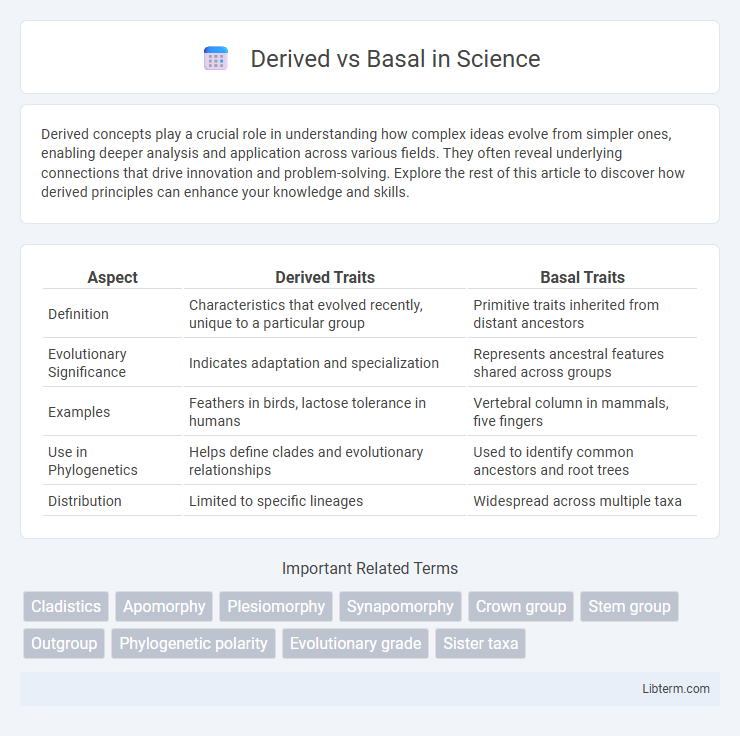Derived concepts play a crucial role in understanding how complex ideas evolve from simpler ones, enabling deeper analysis and application across various fields. They often reveal underlying connections that drive innovation and problem-solving. Explore the rest of this article to discover how derived principles can enhance your knowledge and skills.
Table of Comparison
| Aspect | Derived Traits | Basal Traits |
|---|---|---|
| Definition | Characteristics that evolved recently, unique to a particular group | Primitive traits inherited from distant ancestors |
| Evolutionary Significance | Indicates adaptation and specialization | Represents ancestral features shared across groups |
| Examples | Feathers in birds, lactose tolerance in humans | Vertebral column in mammals, five fingers |
| Use in Phylogenetics | Helps define clades and evolutionary relationships | Used to identify common ancestors and root trees |
| Distribution | Limited to specific lineages | Widespread across multiple taxa |
Introduction to Derived and Basal Concepts
Derived traits, also known as apomorphic traits, represent characteristics that have evolved from an ancestral state, indicating evolutionary advancements within a clade. Basal traits, or plesiomorphic traits, are ancestral characteristics retained from common ancestors and serve as reference points for understanding evolutionary relationships. Understanding the distinction between derived and basal traits is essential for constructing accurate phylogenetic trees and interpreting the evolutionary history of organisms.
Defining Derived vs Basal in Biological Context
Derived traits in biology refer to characteristics that have evolved recently and are present in a particular group but absent in distant ancestors, indicating evolutionary advancement or modification. Basal traits are ancestral features retained from common ancestors, representing the original condition within a lineage. Understanding the distinction between derived and basal traits is crucial for reconstructing phylogenetic relationships and tracing evolutionary history.
Historical Perspectives on Derived and Basal
Historical perspectives on derived and basal traits have evolved significantly since early phylogenetic studies aimed to classify organisms based on observable characteristics. Initially, basal traits were considered primitive features present in common ancestors, while derived traits emerged later as adaptations or innovations within specific lineages. Advances in molecular biology and cladistics have refined the understanding of these terms, emphasizing the importance of shared ancestry and evolutionary branching patterns in interpreting the distribution of derived versus basal characteristics across taxa.
Key Differences Between Derived and Basal Traits
Derived traits are evolutionary adaptations that appear in recent ancestors and distinguish a group from its ancestors, while basal traits are ancestral characteristics retained from distant ancestors. Derived traits often indicate specialization and evolutionary advancement, whereas basal traits represent primitive features common to a broader group. The key difference lies in derived traits reflecting evolutionary innovation, whereas basal traits signify original, conserved attributes.
Morphological Examples: Derived vs Basal Features
Derived features refer to morphological traits that have evolved from an ancestral form and are unique to a particular group, such as the presence of feathers in birds distinguishing them from other reptiles. Basal features are ancestral characteristics shared by multiple groups, like the presence of a vertebral column in vertebrates, indicating common descent. Examples include the basal trait of pentadactyl limbs in tetrapods versus the derived modification of wings in bats and birds.
Phylogenetic Analysis: Interpreting Derived and Basal
Phylogenetic analysis distinguishes derived traits as evolutionary characteristics that have appeared more recently in a lineage, whereas basal traits represent ancestral features closer to the common ancestor. Interpreting derived and basal states helps reconstruct evolutionary relationships by identifying shared derived characters (synapomorphies) that define clades. Accurate identification of basal and derived traits is critical for inferring branching patterns and understanding the evolutionary history within phylogenetic trees.
Evolutionary Significance of Derived and Basal Lineages
Derived lineages exhibit traits that evolved more recently, reflecting adaptations to changing environments and highlighting evolutionary innovation. Basal lineages retain ancestral characteristics, providing critical insights into the primitive states of clades and evolutionary history. The contrast between derived and basal lineages elucidates the processes of diversification and helps reconstruct phylogenetic relationships.
Misconceptions About Derived and Basal Terms
Derived and basal terms are often misunderstood in evolutionary biology; derived traits refer to features that evolved more recently and distinguish a group, while basal traits are more ancestral characteristics shared with earlier common ancestors. A common misconception is that basal means primitive or less evolved, but basal taxa have simply retained ancestral traits and are not less complex or inferior. Accurate interpretation of these terms is essential for understanding phylogenetic trees and evolutionary relationships correctly.
Applications in Taxonomy and Systematics
Derived traits, also known as apomorphies, are critical in taxonomy and systematics because they help define clades by indicating evolutionary novelties unique to a group, enabling precise classification and phylogenetic analysis. Basal traits, or plesiomorphies, represent ancestral characteristics that provide context for evolutionary relationships but are less informative for distinguishing closely related taxa. Utilizing derived versus basal traits allows taxonomists to construct accurate phylogenetic trees, enhancing the understanding of lineage divergence and species evolution.
Conclusion: The Role of Derived and Basal in Evolutionary Studies
Derived and basal traits are critical for understanding evolutionary relationships, with basal traits representing ancestral characteristics and derived traits indicating evolutionary novelties. Analyzing these traits enables researchers to reconstruct phylogenetic trees and infer lineage divergence. The distinction between derived and basal features thus facilitates more accurate identification of evolutionary patterns and the history of species adaptation.
Derived Infographic

 libterm.com
libterm.com